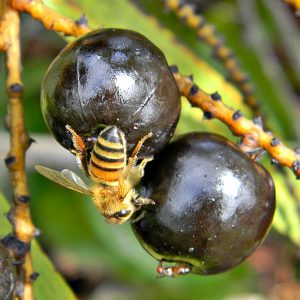What is Saw Palmetto
Saw Palmetto, also called Serenoa Repens, is a plant that is native to the southeastern region of the United States. The verdure is distinct from typical shrubbery by having leaves that bear the appearance of a fan and sharp stalks. Saw palmetto is an extract taken from the purple berries of the Serenoa Repens plant. This article looks at various research on saw palmetto hair loss connections.
Research on Saw Palmetto Hair Loss Connections
Saw palmetto gained attention from the medical research community in recent years as a potential component of hair loss treatments. The studies so far have looked for saw palmetto hair loss connections, such as the effect of the natural product on hair growth and its ability to treat androgenetic alopecia (5, 6, 8, 10). While these studies may show promising signs, a plethora of literature surrounding saw palmetto's various biological properties. This article will summarize the role of the plant in relevant hair loss research.

Saw Palmetto: General Uses of The Extract
Saw Palmetto has been used to treat various illnesses in men and women. Such ailments include:
- Testicular inflammation
- Urinary tract inflammation
- Coughing
- Respiratory congestion
The extract is also a natural remedy to treat the thyroid gland and balance metabolism in women. Additionally, some are used as a dietary supplement that stimulates the appetite and helps with digestion.
Saw Palmetto History
Although some are just now discovering the wonders of the purple berries of the Serenoa Repens plant, saw palmetto has been in the sphere of medicine for several hundred years. The natural remedy was a staple in American folk medicine. In fact, the plant was used to treat various health problems (1). Native Americans employed the berries when treating male urinary tract infections during the eighteenth century. European settlers later learned of the benefits associated with saw palmetto and began using the remedy to gain weight and promote reproductive health. The extract was also the go-to source for treating prostate problems (1).

Saw Palmetto Hair Loss Studies: Suppressing DHT
Several studies have exhibited the potential that saw palmetto has in hair growth (5, 6). Analyses conducted by J SteroidBiochem Mol Biol (1995) saw palmetto as a more effective remedy for hair augmentation than finasteride (5). Research performed by Urology seven years later confirmed the previously observed efficiency of saw palmetto hair growth (6). The lipo stearolic extract of Serenoa Repens (LSESr) was effective in insect cells during the experiments (4). Further observation of 1,098 patients published by Prostate (1996) exhibited Serenoa Repens’ impactful suppression of Dihydrotestosterone, often abbreviated as DHT (2). The androgen molecule DHT is believed to be a major contributing factor to genetic hair loss in men. As testosterone breaks down, the DHT in the bloodstream can attach to the androgen receptors on hair follicles. This results in the miniaturization of the affected hair follicle until it is completely gone. Finasteride, a product created specifically for hair restoration, attempts to increase blood flow to the scalp. However, due to the genetic component of androgenetic alopecia, it is not always effective for all individuals. In a study comparing Minoxidil and Saw palmetto, the natural plant was found to be more potent in treating hair loss (9).
Saw Palmetto Hair Loss Research - Androgenic Alopecia

Androgenetic alopecia (AGA) occurs when hair follicles begin to recede in a pattern. Testosterone is the main contributor to the condition. Its conversion to Dihydrotestosterone by way of enzyme 5-alpha-reductase (5AR) leads to longer rest periods in the hair growth cycle in which follicles do not advance. A study conducted by J. Altern Complement Med (2002) tested LSESr and its alleged ability to suppress DHT by inhibiting 5AR. A select few of 100 candidates suffering from AGA were given 320 mg of saw palmetto daily for two years. The result was follicle progress in 38 percent of those administered the natural remedy (8). Such an outcome was quite instrumental in establishing saw palmetto hair growth as a potentially effective treatment for AGA. The study served as justification for more experiments. An analysis published by Evid Based Complement Alternat Med (2011) made an even stronger case of Serenoa Repens by demonstrating the effectiveness of the plant when combined with a thioctic acid, carnitine, and other anti-inflammatory agents (3). In alignment with this research, hair products that include saw palmetto as one of their key ingredients, like Gashee's Botanical Hair Lotion and Botanical Hair Pomade, show visible changes in hair thickness and density.
Safety Profile for Saw Palmetto
Saw palmetto's Environmental Working Group ingredient hazard score is 1 (green) on a scale of 1-10, with 1 representing the lowest possible hazard rating and 10 representing the highest hazard tier. The final scale rating reflects scores assigned for 17 general hazard categories — including cancer, reproductive/developmental toxicity, and neurotoxicity.
Precautionaries
Although the idea of saw palmetto hair growth is promising, there are a few things to consider:
- Cramps, nausea, diarrhea, and headache are minor side effects of Serenoa Repens.
- Saw palmetto could interfere with drugs that treat hormone conditions.
Other Uses of Saw Palmetto
Although saw palmetto is recognized as a DHT blocker for male pattern hair loss, research also supports its ability to benefit prostate and urinary health. Scientists are also finding that saw palmetto might lower inflammation and safeguard against the growth of cancer cells. However, all of these applications require further research.
It is always wise to discuss treatments with your physician before ingesting any new drug.
Questions about the use of saw palmetto in hair loss research? Contact us.
Natural Hair Products With Saw Palmetto
If you're interested in adding saw palmetto to your beauty routine, Dr.UGo Gashee has two products using this key ingredient to boost your hair health. Our hair lotion and pomade are carefully formulated to improve your hair growth journey using a combination of all-natural ingredients. Click the image below to learn more!


Frequently Asked Questions about Saw Palmetto Hair Loss Research
Can I use saw palmetto for women's hair loss?
An effective treatment would need to prevent DHT from minimizing hair follicles. This is partly because women with the AGA trait tend to lose hair diffusely. Recent saw palmetto hair loss research has shown that certain extracts from the plant are more effective at suppressing DHT production than Finasteride (4,5,6,10).
What are the benefits of using saw palmetto for hair loss?
Saw palmetto had been observed to be an effective inhibitor of the 5α-reductase enzyme (4,5). This enzyme is responsible for the conversion of testosterone to dihydrotestosterone (DHT). With 5α-reductase prevented from converting this androgen compound, the lower levels of DHT in the bloodstream may reduce the rate of follicular minimization.
What is the saw palmetto hair loss dosage?
Studies have shown that the max daily dose of saw palmetto hair regrowth treatment is 320mg (7,9). Researchers suggest splitting the saw palmetto hair loss dosage into two daily 160mg doses (9).
Further Reading
Eugenol and natural products in hair loss research
References
- Borchers, Andrea T., et al. "Inflammation and Native American medicine: the role of botanicals–." The American journal of clinical nutrition 72.2 (2000): 339-347.
- Carro JC, Raynayd JP, Koch G, et al. Comparison of phytotherapy (Permixon) with finasteride in treating benign prostate hyperplasia: a randomized international study of 1,098 patients. Prostate 1996;29(4):231-40; discussion 241-2.
- Chittur S, Parr B, Marcovici G. Inhibition of inflammatory gene expression in keratinocytes using a composition containing carnitine, thioctic Acid and saw palmetto extract. Evid Based Complement Alternat Med 2011;2011:985345.
- Delos S, Iehle C, Martin PM, et al. Inhibition of the activity of basic alpha-reductase (Type 1) detected in DU 145 cells and expressed in insect cells. Steroid Biochem Molec Biol. 1994; 48:347-52.
- Iehlé C, Dé los S, Guirou O, Tate R, Raynaud JP, Martin PM. Human prostatic steroid 5 alpha-reductase isoforms – a comparative study of selective inhibitors. J Steroid Biochem Mol Biol 1995;54(5-6):273-9.
- Marks LS, Hess DL, Dorey FJ, et al. Tissue effects of saw palmetto and finasteride: use of biopsy cores for in situ quantification of prostatic androgens. Urology 2001;57(5):999-1005.
- Murugusundram S. Serenoa repens: does it have any role in the management of androgenetic alopecia? J Cutan Aesthet Surg 2009;2(1):31-2.
- Prager N, Bickett K, French N, et al. A randomized, double-blind, placebo-controlled trial to determine the effectiveness of botanically derived inhibitors of 5-alpha-reductase in the treatment of androgenetic alopecia. J Altern Complement Med 2002; 8(2):143-52.
- Rossi A, Mari E, Scarno M, et al. Comparative effectiveness of finasteride vs. Serenoa repens in male androgenetic alopecia: a two-year study. Int J Immunopathol Pharmacol 2012;25(4):1167-73.
- Swoboda H, Kopp B. Serenoa repens - the saw palmetto or dwarf palm. Wien Med Wochenschr 1999; 149:235.




